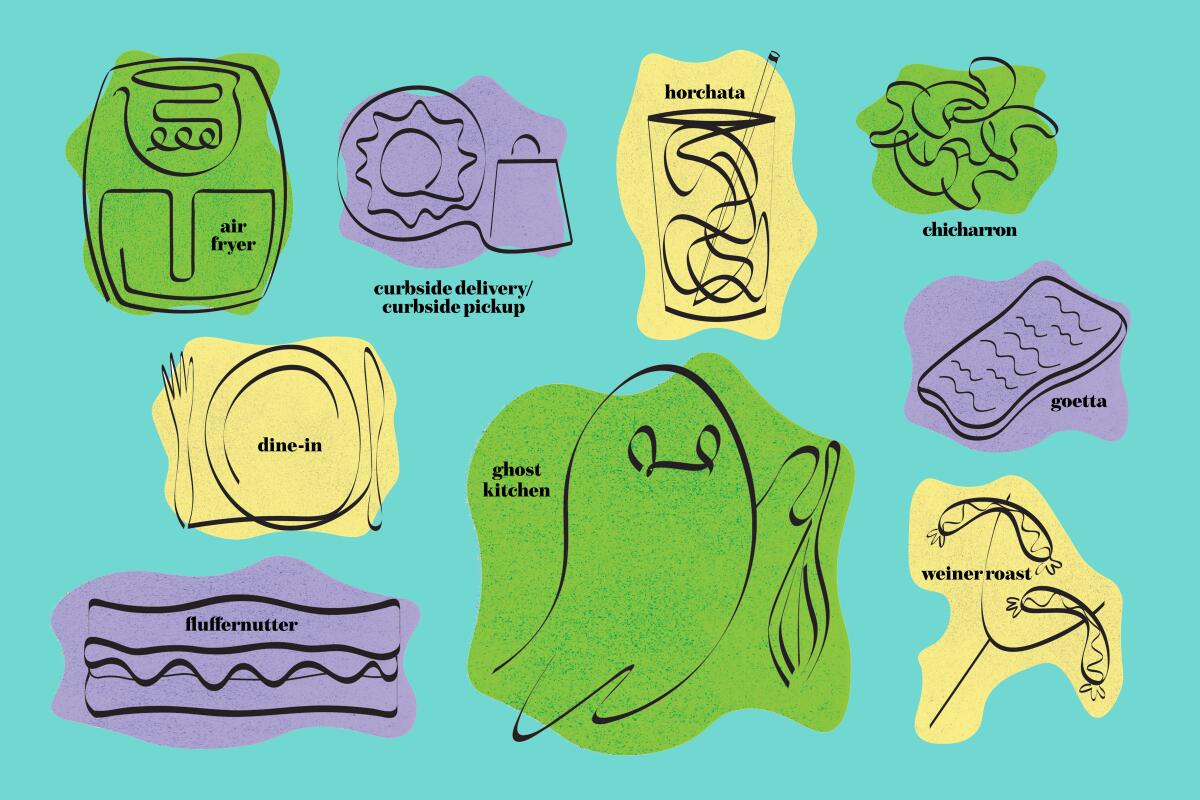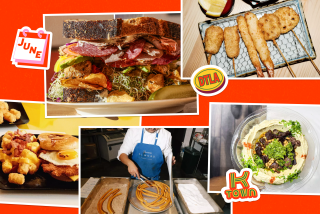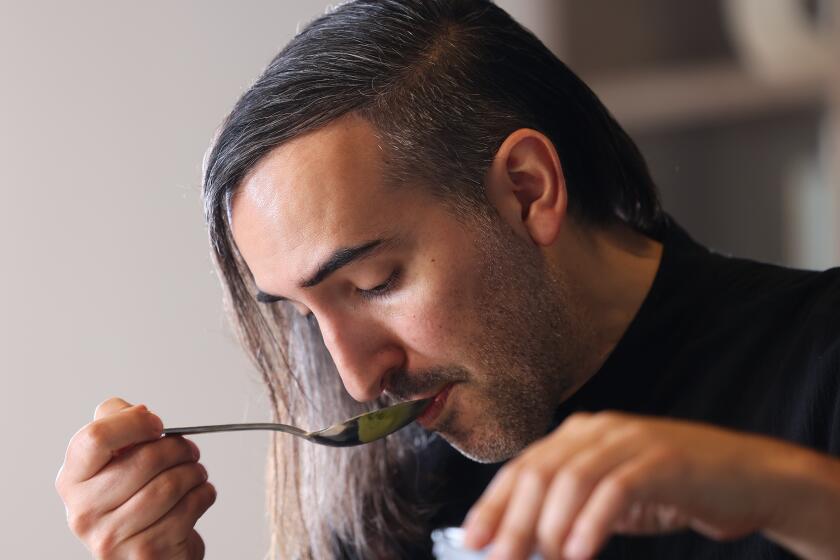From fluffernutter to horchata — how do new food words make it into the dictionary?

Fluffernutter: a sandwich made with peanut butter and marshmallow crème between two slices of white sandwich bread.
If you’re from the Northeast, you may be familiar with the sweet “delicacy” known as fluffernutter. While the sandwich is most popular in the New England area (it was invented in Massachusetts in the second decade of the 20th century), its influence and prevalence have spread throughout the country over the past century. In Los Angeles, you’ll find a deep-fried version with bananas at three of Antonia Lofaso’s restaurants (Black Market Liquor Bar, Dama and Scopa Italian Roots). The Little Fish pop-up in Echo Park has been known to serve a fluffernutter for dessert.
But the word fluffernutter didn’t officially enter the Merriam-Webster dictionary until October, along with 455 other new words.
New words often reflect the big stories of the year or notable changes in our culture. The 2021 word of the year is “vaccine,” preceded by “pandemic” in 2020, both testaments to a terrible era.
Other words — clearly — take longer.
Like all additions to this dictionary, fluffernutter started as a “citation,” a record of sorts that includes context and source, which is added to a searchable database. The word was added to that database in 1961 after an editor cited the word‘s use in an advertisement. Over the years, more Merriam-Webster editors watched for its usage, considering the word for inclusion in upcoming editions of the dictionary. But fluffernutter was rejected for inclusion in 1980, and again in 1983, 1993 and 2003, before finally reaching dictionary word status this year.
“This is a word that took its own sweet time getting into the dictionary, but it also shows that the process is the same for every word,” Merriam-Webster editor at large Peter Sokolowski said during a recent call. “We always look for three basic criteria: widespread usage, long-term usage and meaningful usage. When we say long-term and widespread use, there is no specific number, but there is a kind of critical mass that has to be accumulated.”
The word COVID-19 was added to the dictionary just 34 days after its coinage.
Sokolowski is part of a small team of about 25 people who work all day, every day on the dictionary. If he gets excited about a new word, there is no great announcement to his colleagues. Instead, he finds five or six or maybe even 10 examples of that word, drafts a quick definition and enters it into a large shared document to be looked at when the team is considering words for new releases.
“It’s a way of getting things started and allowing a word to grow,” Sokolowski said, clearly excited about what must be one of the fascinating rituals in the reference-book world. “We also have to make the final call, which is the only real executive decision — when to put it in, once it has been used by many people in many places.”
The team is built like a school faculty (and I can’t stop fixating on the fact that a relatively small group makes these important, albeit seemingly random at times, decisions regarding what makes it into the dictionary and when). Some members may be especially proficient in science, math, physics, linguistics or music. At one point, there was an art historian, a biographer and a geographer on staff. But there is no specific expert who works on only one category of word. And there is no Gordon Ramsay examining food-related terms to determine what makes the cut. In considering a food word, the team might take citations from restaurant menus, restaurant reviews and online recipes into account.
“The specialties are important on our end, but we hope you don’t notice it,” Sokolowski said. “We want a diversity of educational backgrounds and every kind of background on staff to make definitions that are for everybody.”
This year, the team believed that fluffernutter had finally reached the required critical mass. The word joined nine other food-related additions, including ghost kitchen, curbside pickup, curbside delivery, dine-in and air fryer. As a group, these words are an obvious reflection of greater socioeconomic change, byproducts of the pandemic and the restaurant shutdown of 2020 that left everyone ordering takeout and delivery, longing for dine-in and googling air fryer recipes for months.
Surprises on the food-word list? Goetta and wiener roast. A wiener roast, I hope, is self-explanatory. But I had to look up goetta. Are you familiar with the fried patties made from meat, oats, onions and spices? The flat, brown meat rectangle hash-brown look-alikes, which were introduced to the U.S. by German immigrants in the 19th century, are popular in Cincinnati — and another example of a slow-moving trend in the dictionary world.
Even more surprising was the addition of horchata and chicharron in 2021, two words that have seemingly forever been part of the Southern California vernacular. As an Angeleno, it’s hard for me to believe that horchata and chicharron only now reached widespread, long-term and meaningful usage, alongside fluffernutter, especially when the dictionary dates the first known usage of chicharron to 1845. But, then, I grew up making frequent family trips to Olvera Street.
“Without question, food terms are the most productive borrowings of words from foreign languages in the last 20 to 25 years,” Sokolowski said. “Over 100 years ago, we had the influx of French haute cuisine like beef Bourguignon and coq au vin, but now we have terms like horchata, which you’d be familiar with if you traveled to Latin America or if you eat frequently in Mexican restaurants. Adding them makes them naturalized citizens of the English language.”
In 2019, halloumi, matcha, concasse, cidery, meadery, chana, royal icing, tallboy and quaffer were added. The years prior, avo, coquito, dragon fruit, flight (as it pertains to tastings), food bank, gochujang, guac, hangry, hophead, iftar, marg, mise en place, mocktail, quaffable, red bush tea, Wagyu, zoodle and zuke made the cut.
(Zoodle and guac made the cut before chicharron and horchata? I blame Chipotle and social media.)
According to Merriam-Webster’s own “look-up popularity” on its website, goetta is in the top 27% of words, chicharron is in the top 14% and fluffernutter is in the top 8%. Widen this linguistic popularity contest to Google, and you’ll find that fluffernutter nets 449,000 search results, goetta has 131,000 and chicharron racks up 45.7 million. I’ll let the numbers speak for themselves.
“We’re looking for the moment when people respond to this as an English word, but also, if it’s something you’re not familiar with and others are, then maybe you should be,” Sokolowski said. “The perception of things as new or foreign changes over time.”
I asked Sokolowski what other food words might be coming soon. He pointed me to a section of the Merriam-Webster website devoted to words the editors are watching. But there is one in particular that Sokolowski has his eye on.
“Orange wine, and it’s almost overdue,” he said.
It is.
More to Read
Eat your way across L.A.
Get our weekly Tasting Notes newsletter for reviews, news and more.
You may occasionally receive promotional content from the Los Angeles Times.











